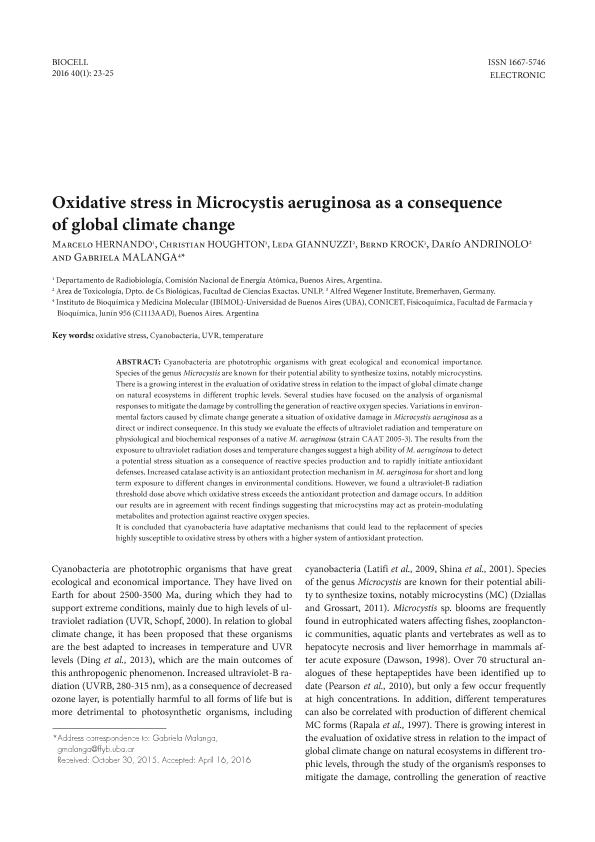Mostrar el registro sencillo del ítem
dc.contributor.author
Hernando, Marcelo
dc.contributor.author
Houghton, Christian
dc.contributor.author
Giannuzzi, Leda

dc.contributor.author
Krock, Bernd
dc.contributor.author
Andrinolo, Dario

dc.contributor.author
Malanga, Gabriela Fabiana

dc.date.available
2018-06-21T20:01:54Z
dc.date.issued
2016-10
dc.identifier.citation
Hernando, Marcelo; Houghton, Christian; Giannuzzi, Leda; Krock, Bernd; Andrinolo, Dario; et al.; Oxidative stress in Microcystis aeruginosa as a consequence of global climate change; Sociedad Latinoamericana de Microscopía Electrónica; Centro Regional de Investigaciones Científicas y Tecnológicas; Biocell; 40; 1; 10-2016; 23-25
dc.identifier.issn
0327-9545
dc.identifier.uri
http://hdl.handle.net/11336/49591
dc.description.abstract
Cyanobacteria are phototrophic organisms with great ecological and economical importance.Species of the genus Microcystis are known for their potential ability to synthesize toxins, notably microcystins.There is a growing interest in the evaluation of oxidative stress in relation to the impact of global climate change on natural ecosystems in different trophic levels. Several studies have focused on the analysis of organismal responses to mitigate the damage by controlling the generation of reactive oxygen species. Variations in environmentalfactors caused by climate change generate a situation of oxidative damage in Microcystis aeruginosa as a direct or indirect consequence. In this study we evaluate the effects of ultraviolet radiation and temperature on physiological and biochemical responses of a native M. aeruginosa (strain CAAT 2005-3). The results from the exposure to ultraviolet radiation doses and temperature changes suggest a high ability of M. aeruginosa to detect a potential stress situation as a consequence of reactive species production and to rapidly initiate antioxidant defenses. Increased catalase activity is an antioxidant protection mechanism in M. aeruginosa for short and long term exposure to different changes in environmental conditions. However, we found a ultraviolet-B radiation threshold dose above which oxidative stress exceeds the antioxidant protection and damage occurs. In additionour results are in agreement with recent findings suggesting that microcystins may act as protein-modulating metabolites and protection against reactive oxygen species.It is concluded that cyanobacteria have adaptative mechanisms that could lead to the replacement of species highly susceptible to oxidative stress by others with a higher system of antioxidant protection.
dc.format
application/pdf
dc.language.iso
eng
dc.publisher
Sociedad Latinoamericana de Microscopía Electrónica; Centro Regional de Investigaciones Científicas y Tecnológicas
dc.rights
info:eu-repo/semantics/openAccess
dc.rights.uri
https://creativecommons.org/licenses/by-nc/2.5/ar/
dc.subject
Cianobacteria
dc.subject
Microcystis Aeruginosa
dc.subject
Uv Radiation
dc.subject.classification
Otras Ciencias Biológicas

dc.subject.classification
Ciencias Biológicas

dc.subject.classification
CIENCIAS NATURALES Y EXACTAS

dc.title
Oxidative stress in Microcystis aeruginosa as a consequence of global climate change
dc.type
info:eu-repo/semantics/article
dc.type
info:ar-repo/semantics/artículo
dc.type
info:eu-repo/semantics/publishedVersion
dc.date.updated
2018-06-05T20:05:19Z
dc.journal.volume
40
dc.journal.number
1
dc.journal.pagination
23-25
dc.journal.pais
Argentina

dc.journal.ciudad
Mendoza
dc.description.fil
Fil: Hernando, Marcelo. Comisión Nacional de Energía Atómica; Argentina
dc.description.fil
Fil: Houghton, Christian. Comisión Nacional de Energía Atómica; Argentina
dc.description.fil
Fil: Giannuzzi, Leda. Consejo Nacional de Investigaciones Científicas y Técnicas; Argentina. Univarsidad de La Plata. Facultad de Ciencias Exactas. Departamento de Ciencias Biológicas. Area de Toxicología; Argentina
dc.description.fil
Fil: Krock, Bernd. Alfred Wegener Institute; Alemania
dc.description.fil
Fil: Andrinolo, Dario. Consejo Nacional de Investigaciones Científicas y Técnicas; Argentina. Universidad Nacional de La Plata. Facultad de Ciencias Exactas. Departamento de Ciencias Biológicas; Argentina
dc.description.fil
Fil: Malanga, Gabriela Fabiana. Consejo Nacional de Investigaciones Científicas y Técnicas. Oficina de Coordinación Administrativa Houssay. Instituto de Bioquímica y Medicina Molecular. Universidad de Buenos Aires. Facultad Medicina. Instituto de Bioquímica y Medicina Molecular; Argentina
dc.journal.title
Biocell

dc.relation.alternativeid
info:eu-repo/semantics/altIdentifier/url/https://www.mendoza-conicet.gob.ar/portal/biocell/vol/40_I_1.html
Archivos asociados
